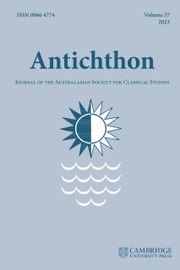No CrossRef data available.
Article contents
Built Space, Written Space: Baroque Spatialities between Architecture and Text in Lucan, Statius, and the Palaces of Imperial Rome
Published online by Cambridge University Press: 27 October 2025
Abstract
This article discusses two imperial Roman literary descriptions of architectural space (Luc. 10.111–35 and Stat. Silv. 4.2) as responses to the real architectural space of two imperial palatial complexes in Rome, Nero’s Golden House and Domitian’s Palatine palace. Building on definitions of baroque spatiality in architecture and on concepts of literary space, it explores the interplay between the textual worlds created by these writers and the real spaces fashioned by Roman imperial architects. It considers the convergences and divergences between the architects’ ‘Baroque’ spatial strategies and the authors’ literary conceits that intimate an illusory materiality, and between the narrated memories or virtual reconstitutions of desolate imperial vastness and the physical experiences of populated space. Finally, it reflects on both differing and common perspectives towards real and literary space constructed in the ‘Baroque’ manner by considering neo-Baroque sensibilities today in both literature and the visual arts and how these might not only problematise but also allow a convergence between the spatial turn of archaeological studies and the exploration of similar spatialities in literary culture.
Information
- Type
- Research Article
- Information
- Copyright
- © The Author(s), 2025. Published by Cambridge University Press on behalf of the Australasian Society for Classical Studies.

